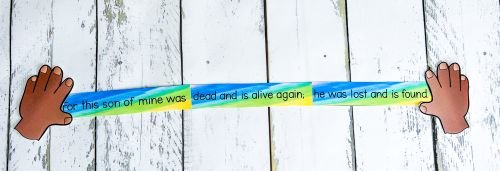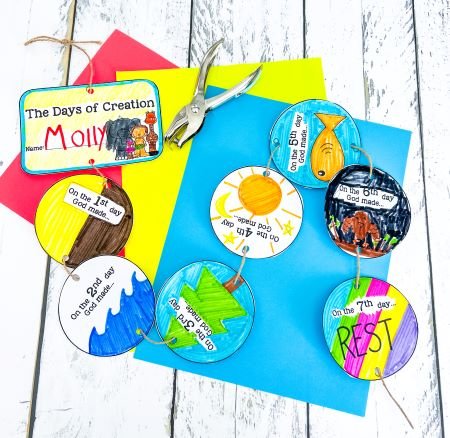There are so many creative ways to teach about Jesus’ Parable of the Lost Coin. This timeless Bible story is a powerful lesson on God’s love and how He rejoices when the lost are found. Whether you're teaching Sunday school, homeschooling, or working in a faith-based school, there are plenty of coin-based engaging activities, hands-on crafts, and printable lesson plans to make learning meaningful and fun. Keep reading for unique ideas that will help kids understand the heart of this parable interactively and memorably!
what’s the parable of the lost coin about?
The Parable of the Lost Coin is found in Luke 15:8-10. In the parable, a woman had ten coins, but one was missing. She searches for a lost coin and is overjoyed when she finds it.
The Parable of the Lost Coin Bible Lessons for Kids
Are you looking for a simple way to teach the Parable of the Lost Coin? Our scripted lesson plans, discussion questions, and printable crafts are perfect for children aged 3 to 8.
BACKGROUND INFORMATION ABOUT THE PARABLE OF THE LOST COIN
This is one of three short parables in Luke 15. The other two are the Parable of the Lost Son and the Parable of the Lost Sheep. All three stories teach the important lesson that God loves us and that we are important to Him. God celebrates when we choose to follow Him.
In this parable, the coin represents a person, and the woman represents God. The ten silver coins in this story would have likely been attached to a piece of jewelry worn by brides, so losing the coin was like losing a treasured possession. Just like the woman searched for the coin, God seeks after us because He treasures us!
THE LOST COIN PRINTABLE CRAFT FOR PRESCHOOL
Crafts are a great way to engage kids in the story and serve as a visual reminder so they can retell the story to their families at home. For this craft, found in The Parable of the Lost Coin for Preschool, kids will make a simple printable coin with a verse from the story on the back. This hands-on project reinforces the lesson and encourages them to share their learning.
“Rejoice with me; I have found my lost coin!” Luke 15:9b NIV
The Lost Coin Printable Craft for Older Kids
Older kids will enjoy a slightly more challenging craft: constructing a paper envelope using the template from Parable of the Lost Coin for Older Kids. They will create a rectangular envelope by cutting and folding on the appropriate lines.
Inside the envelope, kids will put four printable coins. Each coin tells a part of the parable:
Suppose a woman has ten silver coins and loses one
Doesn’t she light a lamp, sweep the house, and search carefully until she finds it?
And when she finds it, she calls her friends and neighbors together and says, “Rejoice with me; I have found my lost coin.”
In the same way, I tell you, there is rejoicing in the presence of the angels of God over one sinner who repents.
OTHER ACTIVITIES TO TEACH THE PARABLE OF THE LOST COIN
Coin Rubbings - Gather various coins. Place a piece of thin white paper over each coin. Have kids color over the coin using the side of a crayon (with the paper wrapping removed). The raised parts of the coin’s design will appear on the paper as they rub. This is an excellent activity for exploring the details of different coins!
Playdough Coin Imprints: Give each kid playdough and coins. Have kids press the coins into the playdough. They will get some fun imprints!
Coin Hunt: This activity can be done in several ways. You can use real coins, print images of coins, or buy chocolate coins from the Dollar Store. Hide the coins around the class and have kids go hunting for them! You could also turn this into a relay where kids race through a relay course to get to the coins at the other end of the room.
Coin Sensory Bin: Fill bins with sand, rice, or beans. Then, put coins, shovels, and other sand toys in the bins. Kids can hide the coins in the sensory bins and dig around to find them.
YOUTUBE VIDEOS ABOUT THE PARABLE OF THE LOST COIN
YouTube can be an excellent resource for helping kids visualize a story better. But it’s imperative to preview any video you plan on showing to make sure it is age-appropriate and matches the lessons you want your kids to learn. Here are some suggestions:
Saddleback Kids’ Parable of the Lost Coin or Wildwood Treehouse (Parable of the Lost Coin)
This parable is part of a three-parable lesson that Jesus taught. This video by LifeKids teaches about all three parables: a lost sheep, a lost coin, and a lost son.
WANT TO CONTINUE LEARNING ABOUT THE PARABLE OF JESUS?
This lesson is part of a five-week series on the parables Jesus told. The other stories include The Wise and Foolish Builders, The Lost Sheep, The Parable of the Sower, and The Prodigal Son.
These lessons about the Parables of Jesus are also included in the 52-week Bible curriculum for little kids in preschool/kindergarten and bigger kids in first, second, and third grades.
The Parable of the Lost Coin is a fabulous story about God’s deep love for us. Ways to reinforce this lesson include games, crafts, and videos. Whether you teach at home, in Sunday School, or at a faith-based school, we must help kids grasp the powerful truth that they are precious to God.
































































